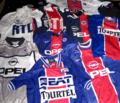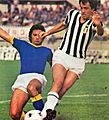Kit (association football) facts for kids
In association football, a football kit is the special uniform and gear that players wear. You might also hear it called a strip or uniform. The rules of football, called the Laws of the Game, say what players must wear. They also stop players from wearing anything that could hurt themselves or others.
Sometimes, different football competitions have extra rules. For example, they might limit how big logos can be on shirts. If two teams have similar colours, the away team usually has to change to different coloured clothes.
Contents
Player Numbers and Names
Footballers usually have special numbers on the back of their shirts. These numbers help everyone know who is who on the field.
How Numbers Started
At first, players wore numbers from 1 to 11. These numbers often matched their playing positions on the field. For example, the goalkeeper might wear number 1.
Modern Squad Numbers
Today, especially in professional football, teams use "squad numbering." This means each player in a team gets a fixed number for the whole season. So, a player might wear number 7, no matter their position in a specific game.
Names on Shirts
Professional football clubs also usually put players' last names or nicknames on their shirts. These names are often found above or below the squad numbers. This makes it even easier to identify players during a match.
How Football Kits Have Changed
Football kits have changed a lot over time. They look very different now compared to when the sport first started.
Early Football Kits
In the early days of football, players wore heavy clothes. They often had thick cotton shirts and knickerbockers, which are like baggy shorts. Their boots were heavy and stiff leather.
Changes in the 20th Century
As time went on, football gear became much lighter and more comfortable.
- Boots: Boots became lighter and softer, making it easier for players to run and kick.
- Shorts: Players started wearing shorter shorts.
- Shirts: New ways of making clothes meant shirts could be made from light, synthetic materials. These new materials allowed for brighter colours and more complex designs.
Sponsors and Fans
In the 20th century, advertising became very popular.
- Sponsor Logos: Companies started paying clubs to put their logos on team shirts.
- Replica Kits: Clubs also began selling copies of their team kits to fans. These "replica strips" became very popular. Selling these kits brings in a lot of money for football clubs.
Images for kids
-
Pavel Nedvěd pictured in 2006 wearing a typical modern football kit
-
The home shirt of Olympique de Marseille for the 2006–07 season
-
The New Brompton team of 1894 sporting typical kit of the era, including heavy jersey, long shorts, heavy high-topped boots and shin pads worn outside the stockings. Goalkeepers wore the same shirts as their team-mates at this point in time.
-
By the early 20th century, shorts had become shorter and goalkeepers wore shirts of a different colour, as seen in this photograph of Internazionale in 1910
-
The national team of Argentina in typical kit of the early 1960s
-
Sponsored shirts, such as these worn in various seasons by Paris St Germain, became the norm in the modern era.
See also
 In Spanish: Equipamiento de los futbolistas para niños
In Spanish: Equipamiento de los futbolistas para niños














